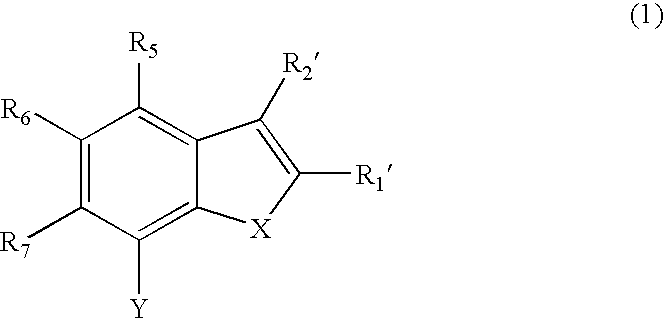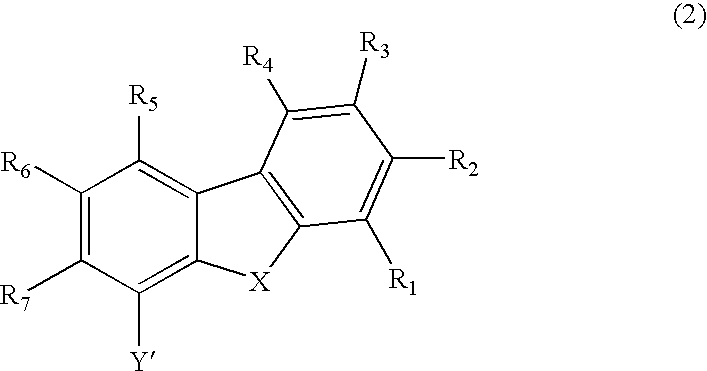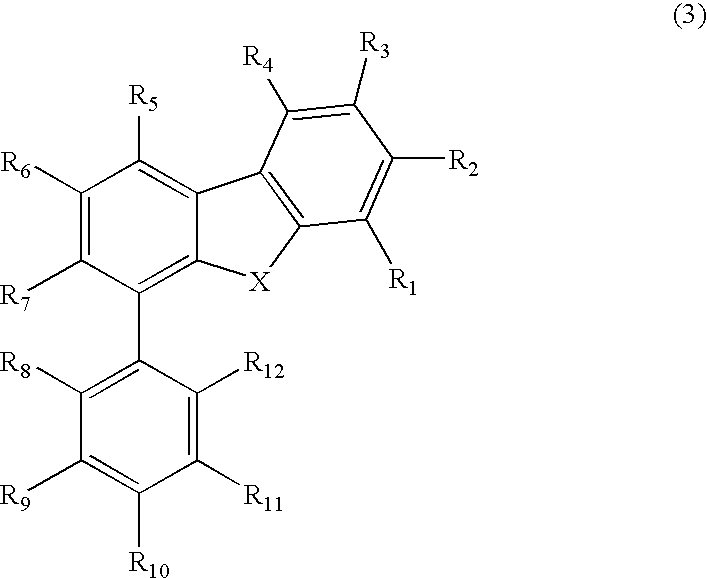Material for organic electroluminescence device and electroluminescence device employing the same
a technology of electroluminescence device and material, which is applied in the direction of discharge tube luminescnet screen, other domestic articles, natural mineral layered products, etc., can solve the problems of defect pixels, easy crystallization, short circuit, etc., and achieve excellent heat resistance, long life, and great light emission efficiency
- Summary
- Abstract
- Description
- Claims
- Application Information
AI Technical Summary
Benefits of technology
Problems solved by technology
Method used
Image
Examples
synthesis example 1 (
Synthesis of D1)
[0150]
[0151] Into a 300 ml three-necked flask, 3.75 g (17.7 mmole) of 4-dibenzofuranboric acid and 1.02 g (0.885 mmole) of tetrakis-(triphenylphosphine)palladium were placed under the atmosphere of argon, and the flask was purged with argon. To the above mixture, 53.1 ml of 1,2-dimethoxyethane, 0.810 ml (6.73 mmole) of 1,4-dibromobenzene and 26.6 ml of a 2.0 M aqueous solution of sodium carbonate (53.1 mmole) were added, and the resultant mixture was heated under the atmosphere of argon in the refluxing condition for 8 hours. After the reaction fluid was filtered, the obtained solid substance was washed with water, methanol and methylene chloride, and 2.72 g (6.63 mmole; the yield: 98%) of Compound 1 was obtained. The obtained substance was identified to be the object compound in accordance with 90 MHz 1H-NMR and FD-MS (the field desorption mass spectroscopy). The result of FD-MS is shown in the following.
[0152] FD-MS: calcd. for C30H18O2=410; found: m / z=410 (M+, 10...
synthesis example 2 (
Synthesis of E1)
[0154]
[0155] Into a 300 ml three-necked flask, 3.42 g (15.0 mmole) of 4-dibenzothiopheneboric acid and 0.867 g (0.750 mmole) of tetrakis(triphenylphosphine)palladium were placed under the atmosphere of argon, and the flask was purged with argon. To the above mixture, 45.0 ml of 1,2-dimethoxyethane, 0.688 ml (5.70 mmole) of 1,4-dibromo-benzene and 22.5 ml of a 2.0 M aqueous solution of sodium carbonate (45.0 mmole) were added, and the resultant mixture was heated under the atmosphere of argon in the refluxing condition for 8 hours. After the reaction fluid was filtered, the obtained solid substance was washed with water, methanol and methylene chloride, and 1.64 g (3.71 mmole; the yield: 54%) of Compound 2 was obtained. The obtained substance was identified to be the object compound in accordance with 90 MHz 1H-NMR and FD-MS (the field desorption mass spectroscopy). The result of FD-MS is shown in the following.
[0156] FD-MS: calcd. for C30H18S2=442; found: m / z=442 (M...
synthesis example 3 (
Synthesis of Compound E4)
[0157] The route of synthesis of Compound E4 is shown in the following.
[0158] Into a 300 ml three-necked flask, 6.04 g (26.5 mmole) of 4-dibenzothiopheneboric acid, 2.25 g (7.14 mmole) of 1,3,5-tribromo-benzene and 2.30 g (1.99 mmole) of tetrakis(triphenylphosphine)-palladium were placed under the atmosphere of argon, and the flask was purged with argon. To the above mixture, 79.5 ml of 1,2-dimethoxy-ethane and 39.8 ml of a 2.0 M aqueous solution of sodium carbonate (79.5 mmole) were added, and the resultant mixture was heated under the atmosphere of argon in the refluxing condition for 16 hours. After the reaction fluid was filtered, the obtained solid substance was washed with water, methanol and methylene chloride, and 1.78 g (2.85 mmole; the yield: 40%) of Compound 4 was obtained. The obtained substance was identified to be the object compound in accordance with 90 MHz 1H-NMR and FD-MS (the field desorption mass spectroscopy). The result of FD-MS is sh...
PUM
| Property | Measurement | Unit |
|---|---|---|
| glass transition temperature | aaaaa | aaaaa |
| peak wavelength | aaaaa | aaaaa |
| work function | aaaaa | aaaaa |
Abstract
Description
Claims
Application Information
 Login to View More
Login to View More - R&D
- Intellectual Property
- Life Sciences
- Materials
- Tech Scout
- Unparalleled Data Quality
- Higher Quality Content
- 60% Fewer Hallucinations
Browse by: Latest US Patents, China's latest patents, Technical Efficacy Thesaurus, Application Domain, Technology Topic, Popular Technical Reports.
© 2025 PatSnap. All rights reserved.Legal|Privacy policy|Modern Slavery Act Transparency Statement|Sitemap|About US| Contact US: help@patsnap.com



